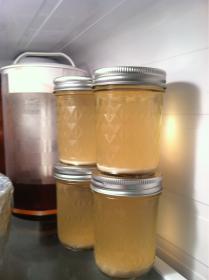Polaris96
Member
Thank yew Sir!! This is a wonderful explanation.

I was just more so concerned that the minerals in tap or spring water might produce undesired effects.I just boil unfiltered tap water. I boil all the jars in a big pot, then just cap that boiled water in there. Boiling will drive off the bad stuff.
that's great news def will save money if I use tap water. That's the way I'm gonna go . Thanks for the advice.never had a problem and I have done it this way for 2 years.












I have been brewing quite a while and I never have tried this.
I do the same; only the longest I have stored in the fridge has been 1 month. I decant the beer & make a starter if it's more than 1 week old. You should be fine.So the last few batches I made I decided to save the yeast. I took sanitized mason jars and poured what was left over after kegging from the bottom of my fermenter...left over beer and all. I put it in the fridge in the middle of March. It's now almost July and I plan on making a starter from it next weekend. Is this an acceptable way of doing it or should I go pick up some new vials of yeast? I really didn't wash it...I just collected what didn't fit in my keg and put it in the mason jar. The bottom half is all yeast and the top half is beer.
So the last few batches I made I decided to save the yeast. I took sanitized mason jars and poured what was left over after kegging from the bottom of my fermenter...left over beer and all. I put it in the fridge in the middle of March. It's now almost July and I plan on making a starter from it next weekend. Is this an acceptable way of doing it or should I go pick up some new vials of yeast? I really didn't wash it...I just collected what didn't fit in my keg and put it in the mason jar. The bottom half is all yeast and the top half is beer.
really dumb questions here:
1) Looking at the page 1 pictures, why not just give the remaining bit of beer in the primary, the trub, and the yeast a good shake...what's the point of adding water?
Also what really is the point of washing, just to separate the trub from the yeast and beer? You aren't really "washing" it as in separating it from the rest of the beer that was left over from racking, you are really only separating it from the trub and left over hops, right?
I want to make a cider tonight on an ale yeast cake but I used my bottling bucket (and need it) as my primary so in addition to racking the beer to secondary, I plan to remove all the trub/yeast/beer and put it into a new fermenter to throw the apple juice on top of. Is my best plan of attack, since I'm going through the trouble of moving the yeast to a new vessel, to follow the steps described in the illustrations? What else could I do more quickly to most efficiently separate the yeast from the trub/hops? How much of the slurry should I use, and (just to reiterate my original questions) what really am I trying to do in keeping just the 'stuff' that has not settled after shaking and let sit for 20 minutes?
Brent_in_Aurora said:I washed some 1084 Irish Ale yeast from a primary fermenter. I boiled water and pint mason jars and stored it in my fridge for about a month. I tried to restart the yeast in a flask with 1/4 cup of DME and 600ml water, which was boiled and chilled to 70 degrees. I poured off most of the excess water and added the yeast that had separated out into two distinct layers on the bottom of the mason jar.
Since then, I have not detected much yeast activity. The bottom creamy layer may have increased, but no bubbles of CO2 perculating. There were some surface foam bubbles, but not much. I poured some off and tasted it and it did not taste sweet.
My question is the yeast dead?
I have been brewing quite a while and I never have tried this. Perhaps I was just overwhelmed and then forgot. I think I will try to salvage some US-05 that is in fermentation stage now. The guide here is superb!

MJDore said:This is the third time I've followed the process and I've had good results. This particular time, though, my jars have a very hazy, pale straw color. I've attached a pic. This doesn't look like any of the other yeast I've washed. Typically the color of the water on top is pale brown. Have you guys had any look like this? This was the second use of a WLP029 German Ale/Kolsch. Thanks!
If I do wash and save my yeast, I should only re-use this yeast for a recipe that calls specifically for the yeast strain that it originally came from, correct? If this is correct, then that leads me to believe after one has experimented and come up with some "reliable" beers they like, this would really be the ticket....